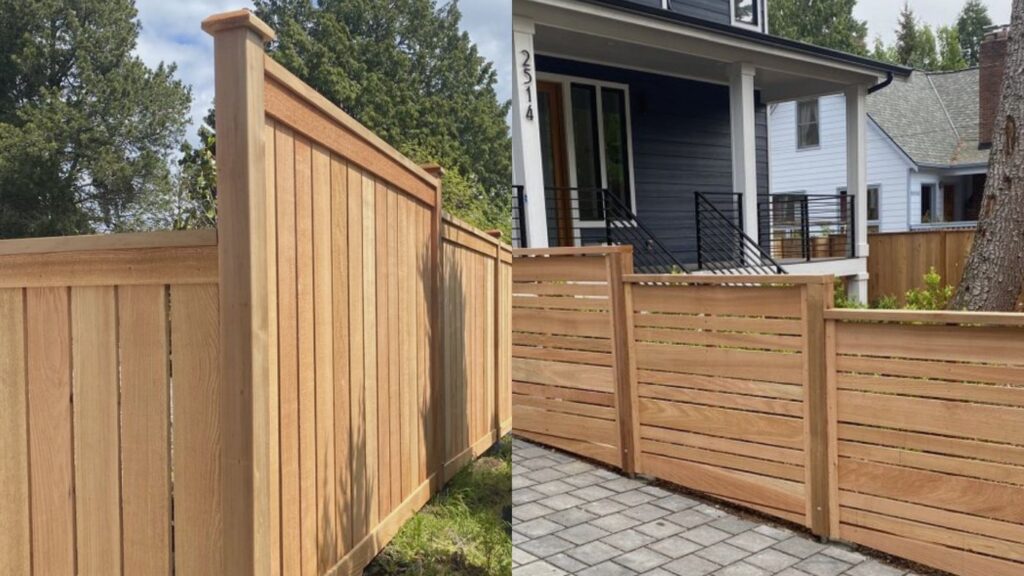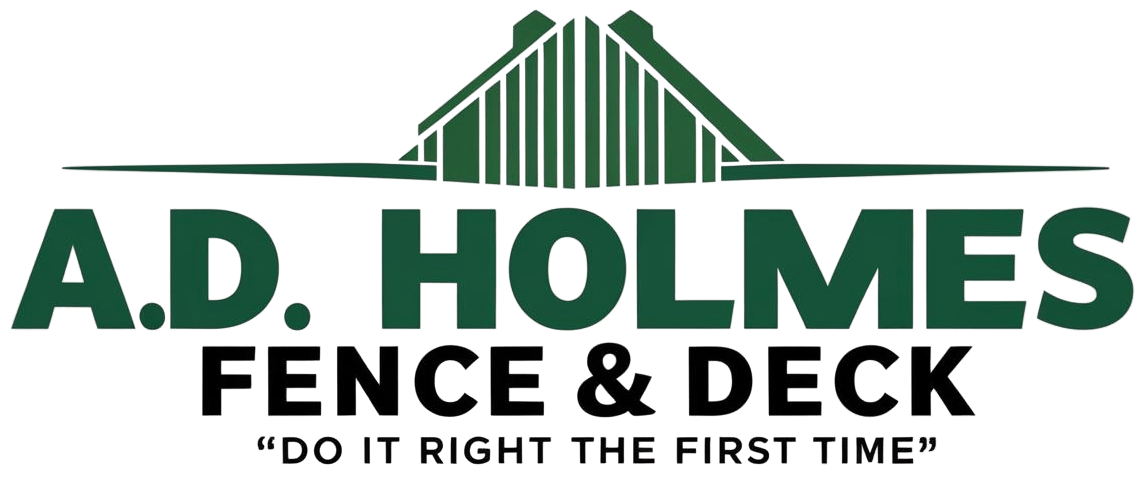
When it comes to choosing the perfect fence for your home, one of the most important decisions you’ll make is whether to go with vertical or horizontal fence boards. Both orientations offer distinct advantages and aesthetic qualities that can dramatically transform your outdoor space. At A.D. Holmes Fence & Deck, we’ve been helping homeowners across Newmarket, Aurora, Markham, and the greater York and Durham regions make this crucial decision for over 20 years.
The orientation of your fence boards doesn’t just affect how your property looks—it impacts everything from maintenance requirements to long-term durability, cost considerations, and how well your fence complements your home’s architectural style. Understanding these differences is essential to making an informed choice that you’ll be happy with for years to come.
The Traditional Appeal of Vertical Fence Boards
Vertical fencing has been the gold standard for residential properties for decades, and for good reason. This classic orientation offers several compelling advantages that continue to make it a popular choice among Canadian homeowners.
Structural Superiority and Durability
Vertical fence boards provide exceptional structural integrity due to their natural alignment with gravity. Unlike horizontal boards that can sag over time, vertical pickets maintain their position with minimal stress on the supporting framework. This orientation allows for wider post spacing—typically 8 feet apart—which reduces the number of posts required and can help control installation costs.
The durability benefits extend beyond structural considerations. With vertical boards, the most weather-sensitive parts—the board ends—face upward, which naturally allows water to run off rather than pooling on horizontal surfaces. This natural drainage helps prevent moisture accumulation that can lead to rot, mold, and deterioration over time.
Cost-Effectiveness and Installation Flexibility
From a budget perspective, vertical fencing typically offers better value. The construction requires fewer materials since you need fewer posts, and the installation process is generally less complex. Pre-made fence panels are readily available for vertical installations, which can significantly reduce labor costs and installation time.
Vertical fencing also excels on uneven terrain. The boards can be stair-stepped to match ground contours, making it an ideal choice for sloped properties or areas with natural elevation changes. This adaptability means you won’t need extensive grading work, which can add considerable expense to your project.
Timeless Aesthetic Appeal
The vertical orientation offers a timeless look that complements virtually any architectural style. Whether your home features traditional, craftsman, colonial, or farmhouse design elements, vertical fencing provides a classic backdrop that enhances rather than competes with your home’s character. The upward lines can also create an illusion of height, making your property appear more expansive.
The Modern Sophistication of Horizontal Fence Boards
Horizontal fencing has emerged as the contemporary choice for homeowners seeking a sleek, modern aesthetic. This orientation has gained tremendous popularity in recent years, particularly among those looking to create a distinctive, upscale appearance for their property.
Contemporary Visual Impact
Horizontal fence boards create clean, streamlined lines that perfectly complement modern and contemporary home designs. The parallel lines draw the eye along the length of the fence, creating an illusion of expanded space that can make smaller yards feel larger and more open. This visual effect is particularly striking when combined with modern architectural elements like large windows, flat rooflines, and minimalist landscaping.
The horizontal orientation also provides exceptional design versatility. You can adjust the spacing between boards to balance privacy with airflow, create interesting shadow patterns, or incorporate lighting elements for dramatic evening effects.
Enhanced Privacy and Security Features
When installed with tight spacing, horizontal fences can provide superior privacy compared to traditional vertical installations. The continuous horizontal lines create a solid visual barrier that’s difficult to see through, making them ideal for properties where maximum seclusion is desired.
However, it’s important to note that horizontal boards can create a “ladder effect” that might make it easier for intruders to climb. This consideration should be weighed against the privacy benefits, particularly for front-yard installations or areas where security is a primary concern.
Material Considerations and Longevity
Horizontal installations often require higher-grade lumber to prevent sagging, which can increase material costs. However, this investment pays dividends in durability. The horizontal orientation actually protects the most vulnerable parts of the wood—the board ends—by positioning them sideways rather than upward, where they would be more exposed to rain and moisture.
This protection from the elements can significantly extend the fence’s lifespan, making horizontal fencing a smart long-term investment despite higher upfront costs.
Maintenance Requirements and Long-Term Considerations
The orientation of your fence boards significantly impacts maintenance needs and long-term care requirements. Understanding these differences can help you choose the option that best fits your lifestyle and maintenance preferences.
Vertical Fence Maintenance
Vertical fencing generally requires less frequent maintenance due to its natural drainage properties. Water runs off the vertical boards more readily, reducing the risk of moisture-related issues like mold, mildew, and rot. The traditional construction also makes repairs more straightforward—damaged boards can typically be replaced individually without affecting the overall structure.
Regular maintenance tasks include annual cleaning, inspection for loose or damaged boards, and reapplication of stain or sealant every 2-3 years. The vertical orientation makes these tasks easier to perform, as you can access most areas without specialized equipment.
Horizontal Fence Maintenance
Horizontal fencing may require more attentive maintenance due to its design characteristics. The horizontal surfaces can collect water, leaves, and debris, creating conditions that promote mold and mildew growth. Regular cleaning becomes more critical to prevent moisture buildup and maintain the fence’s appearance.
The horizontal orientation also means that if one board warps or sags, it can affect the appearance of the entire section. However, the higher-grade materials typically used in horizontal installations often offset these concerns with superior resistance to warping and weather damage.
Cost Comparison and Budget Considerations
The financial aspects of vertical versus horizontal fencing extend beyond initial purchase price to include installation complexity, material requirements, and long-term maintenance costs.
Initial Investment
Vertical fencing typically offers the most budget-friendly option for most Canadian homeowners. In Ontario, vertical installations generally range from $45-$85 per linear foot, depending on materials and complexity. The wider post spacing and availability of pre-made panels help keep costs manageable.
Horizontal fencing commands a premium, typically ranging from $55-$100+ per linear foot. The higher cost reflects several factors: the need for higher-grade materials to prevent sagging, closer post spacing for adequate support, and the requirement for on-site construction rather than pre-made panels.
Long-Term Value Considerations
While horizontal fencing requires a larger initial investment, it can offer excellent return on investment through increased property value and reduced replacement needs. The contemporary aesthetic appeals to modern buyers and can help your property stand out in the market.
Both orientations can increase property value by 1-10%, according to real estate professionals, but the specific impact depends on your local market, home style, and installation quality.
Architectural Compatibility and Design Harmony
Choosing the right fence orientation to complement your home’s architecture is crucial for creating a cohesive, attractive appearance that enhances your property’s overall appeal.
Traditional and Heritage Home Styles
For colonial, Victorian, craftsman, and farmhouse homes, vertical fencing typically provides the most harmonious match. The classic orientation reinforces the traditional aesthetic and creates visual continuity with the home’s architectural elements. Decorative post caps, varied picket heights, or lattice accents can add custom touches that reflect your home’s unique character.
Modern and Contemporary Architecture
Contemporary homes with clean lines, large windows, and minimalist design elements benefit tremendously from horizontal fencing. The parallel lines echo modern architectural principles and create a sophisticated, unified appearance. Materials like cedar or composite boards in neutral colors can provide the perfect complement to contemporary exteriors.
Transitional and Eclectic Styles
For homes that blend traditional and modern elements, both orientations can work well, depending on which aspects of your architecture you want to emphasize. Mixed-orientation designs that incorporate both vertical and horizontal elements can create unique, custom appearances that reflect your home’s distinctive character.
Climate and Environmental Factors
Canadian weather conditions play a significant role in fence performance and longevity. Understanding how each orientation responds to our climate can help you make the best choice for your specific location.
Weather Resistance
Vertical fencing generally performs better in areas with heavy precipitation, as water naturally runs off the boards rather than pooling on horizontal surfaces. This characteristic is particularly important in regions like Southern Ontario, where freeze-thaw cycles can cause significant damage to moisture-saturated wood.
Horizontal fencing can be more vulnerable to moisture accumulation, especially in areas with high humidity or frequent rainfall. However, proper installation techniques, quality materials, and regular maintenance can mitigate these concerns.
Wind Resistance
Horizontal fencing typically offers superior wind resistance due to its lower profile and the way wind forces are distributed across the parallel boards. This characteristic makes it an excellent choice for properties in exposed locations or areas prone to strong winds.
Making the Right Choice for Your Property
Selecting between vertical and horizontal fence boards ultimately depends on balancing your aesthetic preferences, functional requirements, budget considerations, and maintenance capabilities.
Key Decision Factors
Consider your home’s architectural style and choose the orientation that best complements its design language. Evaluate your privacy needs, security requirements, and how you plan to use your outdoor space. Factor in your budget for both initial installation and ongoing maintenance, and think about your long-term plans for the property.
Professional Installation Benefits
Regardless of which orientation you choose, professional installation is crucial for achieving optimal results. At A.D. Holmes Fence & Deck, our experienced team ensures proper post spacing, adequate drainage, and structural integrity that will provide years of reliable performance. Our craftsmen understand the unique requirements of both vertical and horizontal installations and can guide you toward the best choice for your specific situation.
Quality Materials Make the Difference
Whether you choose vertical or horizontal boards, selecting quality materials is essential for long-term satisfaction. We work with premium lumber suppliers and can recommend the best wood species for your climate, budget, and aesthetic goals. From pressure-treated pine for budget-conscious projects to premium cedar for maximum durability and beauty, we’ll help you find the perfect material for your fence.
The choice between vertical and horizontal fence boards represents more than just an aesthetic decision—it’s an investment in your property’s value, security, and long-term enjoyment. By carefully considering the factors outlined in this guide and working with experienced professionals, you can create the perfect fence solution that enhances your home’s beauty and serves your family’s needs for decades to come.
For expert guidance on choosing the right fence orientation for your property, visit our comprehensive wood fence services page to explore our full range of options. You can also learn more about our complete fencing solutions to see how we can transform your outdoor space with quality craftsmanship and professional installation.
According to the Canadian Fence Industry Association, proper fence installation and material selection are crucial factors in achieving optimal performance and longevity, regardless of board orientation. Their guidelines emphasize the importance of working with qualified contractors who understand local building codes and climate considerations.




